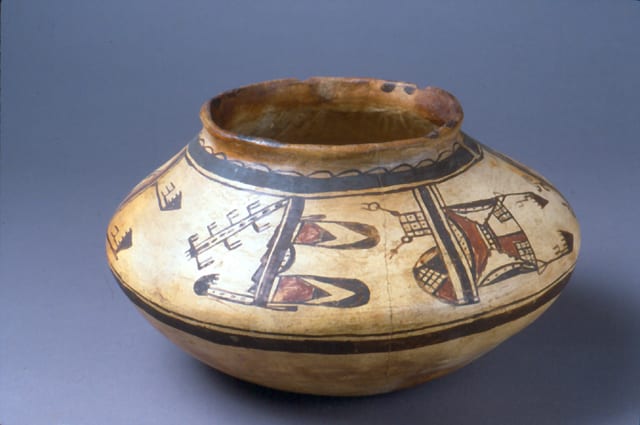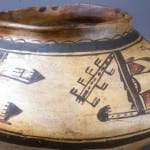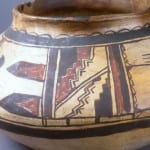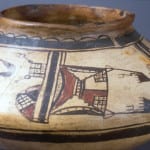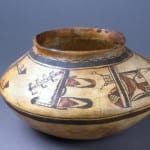The pot (circa 1890) is severely cracked (though stabilized) with a classic Polacca crackled white slip. This is the goofiest-designed pot I have ever seen, much less owned. It is not particularly aesthetic in overall design, in part because it is almost random in layout. The shape of the pot is a Sikyatki-revival shape and the two small panels with stepped design and three or four feather-like designs are also reminiscent of older Sikyatki and Tewa design. On the other hand, the flower-like image in one of these stepped panels seems mostly Spanish in origin. Unlike much Polacca C ware, there is no hint of the Zuni rain-bird design. Overall the decoration seems more like a series of elaborate doodles, sometimes repeated (the arrow-like design) but with variation. There are several unique designs that appear only once on the jar, in sharp contrast to the balance designs used in most Sikyatki revival pottery. One element is clearly a cell phone tower.
Particularly because the design is not representative of a particular tradition, it is hard to make any secure guess as to the time when this pot was produced. Nevertheless, it is my gut sense that this is Polacca “D” Ware, representing a shift from the then-traditional Polacca “C’ designs toward a Sikyatki Revival style. Clearly the potter did not feel bound by traditions of Polacca design, though the crazed slip makes this unquestionably Polacca Ware. I think this is a striking example of artistic design transition, hence my Polacca “D” classification. If so, this piece is a very early tourist pot made probably (why not just guess some more) for trade to Thomas Keam. My fantasy imagines a Hopi woman who has learned that Polacca C shapes and designs do not trade as readily as the “newer” (Sikyatki revival) shapes and designs, but who has little idea of Sikyatki aesthetics. What design might a Bahana trader buy, she might wonder? Good inspiration for a doodle! Although the design is without much tradition or pattern, it is spirited and fun. In a phone conversation (fall 2008), Ed Wade looked at this jar online and agreed with my assessment.
Moreover, when compared to most of the 1,500 pots in the Keam Collection of the Peabody Museum (see Wade and McChesney, 1981), the design seems carefully and skillfully drawn. The amount and intricacy of the patterns indicate that considerable time and care went into its production. For a Polacca “D” pot that has a typical Sikyatki revival design, see 1992-05. Pot 1994-16 is from the collection of Mr. Bert Carlson of Phoenix but “Mr. Carlson does not recall where he obtained the piece, nor does he have any records which would be of any use in tracing further provenance.” (Letter from Lee Cohen, Gallery 10, Inc.)

